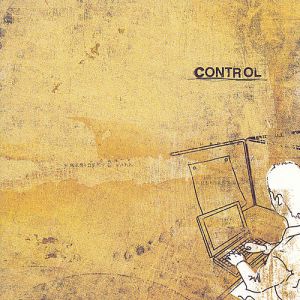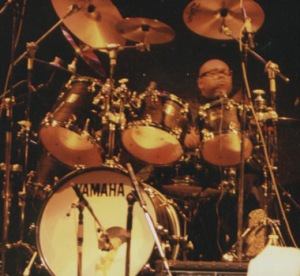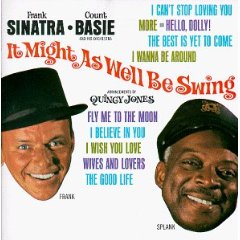You are currently browsing the category archive for the ‘Album of the Week’ category.
 There are things in life that, when you experience them, you know they’re cool. You see a cool movie, or you visit a cool place, and you tell everyone about it because it was cool. There are also experiences that aren’t just cool, but very cool. Not kinda cool – REALLY cool. And then there those rare experiences that are so cool, that you feel like you yourself gained in coolness simply for having had the experience. Listening t0 this album is like that. Listening to this album makes me feel cooler.
There are things in life that, when you experience them, you know they’re cool. You see a cool movie, or you visit a cool place, and you tell everyone about it because it was cool. There are also experiences that aren’t just cool, but very cool. Not kinda cool – REALLY cool. And then there those rare experiences that are so cool, that you feel like you yourself gained in coolness simply for having had the experience. Listening t0 this album is like that. Listening to this album makes me feel cooler.
Raising Sand is the first and only (to date) collaboration between Alison Krauss, the first lady of bluegrass, and Robert Plant, front man for classic rock giants Led Zeppelin. Produced by prominent American musician/producer T-Bone Burnett, and utilizing the playing of some of the world’s top session musicians, the music can best be described as a “roots music” super group. The vibe is dark, brooding, colorful, and incredibly interesting. The songs are mainly covers from the 50’s and 60’s, with an eclectic variety of feels and sounds, but all in the classic “American folk” style.
As I mentioned earlier, this album is cool beyond the belief. It’s cool because of the songs – witty and thoughtful lyrics with catchy but powerful melodies. It’s cool because of the sounds – recorded beautifully with amazingly complex tones and interaction. It’s cool because of the arrangements – fluid and easy, despite a surprisingly heavy use of odd meters and unsymmetrical phrases. And of course it’s also cool because of the vocals – Krauss and Plant are an unlikely duet but work so well together (“one of the most effortless-sounding pairings in modern popular music” according to Allmusic).
But the real reason this album is on the AEDSK list is the cool drumming. Holy cow. Jay Bellerose, a guy with very deep and impressive credits in the studio, is delivering on this record in a way that I’ve never heard anyone play. His grooves, his feel, his sounds, his ideas… they are all amazing and so inspiring. You know that “loose and jangly” feel that americana/folk fans talk about? Bellerose DEFINES that sound on this record. You know that mysterious “between-swing-and-straight” pocket that everybody wants to get into? That’s where Bellerose LIVES for this entire album. You know that vintage “deep-but-dead” tone that’s so popular in the studio right now? Bellerose is a passionate expert on vintage gear, and he nails the sound on every track… but in a way that keeps it simultaneously classic and fresh, not just trendy.
For example…
The groove on “Let Your Loss Be Your Lesson” is the funkiest sounding train/backbeat I’ve ever heard, and then just try and wrap your brain around his pocket during the guitar solo on that tune, not to mention the fill into that section (2:56). Then check out the kick/ride tone on the opening track, “Rich Woman,” and don’t miss the triplet fill after the final choruses (3:10). Listen to the nuances of the one-handed brush feel on “Killing the Blues,” and the tasteful addition of the ride at the slide solo. “Polly Come Home” has so much space… the room he leaves for everyone else is so effective but so difficult to pull off. “Gone Gone Gone” is the coolest treatment of a tumbau pattern. The deep cowbell sound on “Sister Rosetta” is so left field but so perfect. I mean, what is going on with the cymbal/floor tom groove on “Fortune Teller”? How about the awesome but completely unorthodox pattern on the out choruses of “Please Read the Letter”? I could go on and on.
Raising Sand is well worth your money and time to buy it and listen to it. Make it happen.
 As I resume the AOTW posts, my plan is to work through all the records on the AEDSK list, alphabetically. That means the 12Rods are up first… which totally rules. I love this record.
As I resume the AOTW posts, my plan is to work through all the records on the AEDSK list, alphabetically. That means the 12Rods are up first… which totally rules. I love this record.
To set it up, here’s the 12Rods bio from Wikipedia…
12 Rods was formed by Ryan Olcott, Christopher McGuire, Matt Flynn, and Daniel Perlin at Talawanda High School in Oxford, Ohio, in May 1992. They self-released an album called Bliss in 1993 and the gay? EP in 1996, one year after moving to Minneapolis. 12 Rods signed with V2 in 1996 and re-released gay? while they recorded a new album. Split Personalities was released in 1998. Despite the departure of drummer Christopher McGuire, 12 Rods released its next album, the Todd Rundgren-produced Separation Anxieties. The album failed miserably, both critically and commercially, and 12 Rods were dropped by V2. They recorded and released one more album, 2002’s self-released Lost Time, then broke up in 2004.
So the feature for this week is that last record, Lost Time. All of this music business crap happened to these guys, and the music that happened after is AMAZING. The “we’re sick of the music business and we just want to play” overtones are tangible in every song, and that’s definitely one of the reasons this record is so great.
The songwriting, performances, and production is also killer too. It should be noted that at this point the band looked entirely different in personnel. Ryan’s brother Ev Olcott was now on keys/guitar/bvg/production. Christopher McGuire had been replaced by Dave King, and Bill Shaw was on bass.
I’m not going to get into all the various reason I love this album, but I definitely need to make mention of the drumming. Dave King is always rad, but I think this album shows a side of him that you don’t find anywhere else. The combination of pocket, creativity, and chops… all in a pop/rock record… it’s just amazing. Every song has a paradigm-shattering element to it, and it’s all awesome.
For instance, the first fill of the record is completely “wrong” and oh so right. “Twenty For Hours Ago” features a fill over the FIRST bar of every chorus, and it adds so much momentum. There’s a super cool disco thing on “Telephone Holiday” (0:51), then a hilarious break beat in the same track (2:34). Then check out the way King accents the vocal on “One Thing Does Not Belong” (1:23), “Accidents Waiting To Happen” (0:40), and “Terrible Hands” (1:43).
The stuff I just mentioned is all totally rad, but by far my favorite drum moments on this record are all in “Boy In The Woods.” The ghost notes, the drum ‘n bass stuff, the tones… and then the phrase at 1:18… oh my goodness. It kills me EVERY time. Listen, the records that make it in to the “Albums Every Drummer Should Know” list make it in there for a reason.
So go buy Lost Time by the 12Rods and thank me next time we hang out.
I dropped the ball on AOTW for two weeks in a row there. Whoops. Had a busy run for the first half of December I guess.
Anyway, I’m back at it with a great record for this week… and it’s a blast from the past for me. That’s right, for all the haters out there… I’m putting Phish in the AOTW series, and I don’t feel bad about it. When I was in high school I thought Phish was God’s gift to music… the perfect band that played the perfect songs and never did anything that shouldn’t be wholly praised. Well, let’s just say I think a little differently now. I’ve grown as a musician to the point where I see the legitimacy of much of the criticism commonly brought against the jam band giant, and I’ve not listened to them for more than a hour over the last 6 years.
 And yet, this week I resurrected their last studio album, called Undermind. Listen people… it’s good. Ok? Just accept it. Phish made A LOT of good records in my opinion, but this final offer from them is undeniably good, and a record where I think they successfully shed a few of their immature habits from the early years, and in so doing they managed to actually put together a SERIOUS recording from the “Jam Band” genre.
And yet, this week I resurrected their last studio album, called Undermind. Listen people… it’s good. Ok? Just accept it. Phish made A LOT of good records in my opinion, but this final offer from them is undeniably good, and a record where I think they successfully shed a few of their immature habits from the early years, and in so doing they managed to actually put together a SERIOUS recording from the “Jam Band” genre.
A big part of Undermind’s coolness is the fact that it was produced by the fantastic Tchad Blake. Blake has never produced anything that didn’t turn into complete awesomeness… and Phish is no exception. It’s actually a testament to Phish’s ontological cool factor that Blake even agreed to do the record, because I’ve heard he’s prone to rejecting offers from serious bands if he thinks they aren’t hip enough… (rumor has it REM has been trying to get Blake to produce one of their records for 10 years, and he won’t even return their phone calls). Blake took most of the things I’ve always disliked about Jon Fishman (Phish’s drummer) and “fixed” them, all while keeping Fishman in his element. The guitar playing is incredible, which is nothing less than expected from band-leader Trey Anastasio (in fact, I highly recommend his self-titled solo album). The songs are a great example of Phish’s aimless lyrics and smart harmonic composition. The flow of the record is comfortable and natural. And the improvising… well, that’s always been their greatest strength.
So, just indulge me and check out Undermind by Phish. I think you will like it, and if you don’t… I don’t care.
PS. Let me reiterate that Phish is not just a band with a cool record I’ve been listening to lately. Phish’s music was the single-most dominant influence in my formative years of playing music. I’ve seen them 36 times live, and I own over 400 bootleg tapes of their live shows. That’s right… TAPES. The band is an enormous link in the chain of my musical development, and although I don’t consider them to be musical divinity like I once did, I still think anyone/everyone who strives to be creative in making music will benefit from listening to Phish.
 AOTW for this week is probably the heaviest record yet in the series, and I don’t mean instrumentally heavy. Control by Pedro The Lion is a concept album about the pit of American materialism interwoven with the lack of moral fiber in American social and family life. Yeah… heavy. The lyrical content of Control is easily the most artistically deep, dark, controversial, poignant, and powerful of any record that I own. All of these things exist simultaneously in the text of the album, which is itself impressive… but then the music comes in and interprets the message so incredibly spot-on that the record catapults from impressive to utterly brilliant.
AOTW for this week is probably the heaviest record yet in the series, and I don’t mean instrumentally heavy. Control by Pedro The Lion is a concept album about the pit of American materialism interwoven with the lack of moral fiber in American social and family life. Yeah… heavy. The lyrical content of Control is easily the most artistically deep, dark, controversial, poignant, and powerful of any record that I own. All of these things exist simultaneously in the text of the album, which is itself impressive… but then the music comes in and interprets the message so incredibly spot-on that the record catapults from impressive to utterly brilliant.
The only consistent band member in now defunked Pedro The Lion was David Bazan. Control was the band’s 3rd of four official releases. Aside from some auxiliary instrumentation from friend Casey Fourbert, the record is basically just a Bazan solo album: he wrote the songs, sang, played guitar, played bass, played drums, and even played some keys. The sonic vibe of the record is very indie rock, but without too much of the standard 8th note guitar strum. Avoiding stereotypical indie rock guitar playing is one of Bazan’s strengths in my opinion, although the overall indie vibe remains. In fact, Control is probably the only Bazan album that could be fairly called a “rock” record at all – the other Pedro records are much calmer and more acoustic-driven. Control is definitely the loudest and most aggressive record thus far from Bazan, but don’t misunderstand me… this album definitely contains the simplest and most raw instrumental performances of any AOTW feature. As I mentioned above, the real shining point of the playing is the way it so perfectly translates the lyric. A concept album through and through.
Despite its simplicity, I do listen to this record for inspiration in my own playing from time to time. Bazan’s drumming has a great sloppy-but-grooving feeling to it, and his ideas for patterns/fills are creative and appropriate. I particularly love his snare tone, and the way the compression breathes on his crash-ride during the more rocking moments.
I listened to Control last week for the first time in a couple years, and I was reminded how much I love it. In fact, I’d probably put this album in my top-20 favs of all time. You can listen to the record here, and you can check out David Bazan’s current happenings here.
 I recently got a chance to hear some of the rough tracks from Sara Renner‘s upcoming record, for which Michael Bland played all the drums. Oh man. That guy is so good. Hearing his playing on Sara’s music prompted me to revisit the latest Jonny Lang record, Turn Around, which also features Bland on drums, and is now the AOTW for this week. Turn Around is currently one of my favorite albums, and definitely Lang’s best so far. But, if you’re looking for a standard review of the record, then click here, because this post is going to be about Bland.
I recently got a chance to hear some of the rough tracks from Sara Renner‘s upcoming record, for which Michael Bland played all the drums. Oh man. That guy is so good. Hearing his playing on Sara’s music prompted me to revisit the latest Jonny Lang record, Turn Around, which also features Bland on drums, and is now the AOTW for this week. Turn Around is currently one of my favorite albums, and definitely Lang’s best so far. But, if you’re looking for a standard review of the record, then click here, because this post is going to be about Bland.
 Michael Bland is known for basically one thing: Solid. Other appropriate descriptions would be words like “precise,” “exact,” and “perfect.” Nowhere is that more evident than on Turn Around. Bland’s grooves and fills are so tightly and cleanly executed that it literally sounds… well, perfect. BUT, he can also pull out some sick chops whenever he wants to, and the cool thing about Turn Around is that Bland delivers a heavy dose of BOTH the solid and the chops. Nice.
Michael Bland is known for basically one thing: Solid. Other appropriate descriptions would be words like “precise,” “exact,” and “perfect.” Nowhere is that more evident than on Turn Around. Bland’s grooves and fills are so tightly and cleanly executed that it literally sounds… well, perfect. BUT, he can also pull out some sick chops whenever he wants to, and the cool thing about Turn Around is that Bland delivers a heavy dose of BOTH the solid and the chops. Nice.
Take, for instance, the 3rd track on the album, “One Person At A Time.” The shuffle feel is so crisp, but Bland also manages to drop in some very cool ideas… ideas that are NOT easy to play. You can really tell that playing a deep shuffle doesn’t take every ounce of his focus, and he’s able to easily throw curve balls of all kinds into the mix while not sacrificing any of his trademark precision.
Also noteworthy is Bland’s approach on “Thankful.” Listen carefully to this one, and notice how he doesn’t bother with any cymbals other than the hats for the whole track. No crashes, no ride… nothing but hats. The song just relaxes in the thick gospel 4 on the floor that Bland is throwing down, and nothing else is needed.
And then there’s the final track, “It’s Not Over,” where Bland lays out the deepest swung 6/8 cross-stick groove that anybody’s ever heard, and proceeds to mercilessly drive through every rudiment he knows at the tune’s closing. Honestly, I’ve never heard anybody be so grooving and so busy on the same track. It’s refreshing.
I’m gonna try and track down a few more albums that Michael Bland plays on, and I bet they’ll soon make their way into Album of the Week fame. Until then, go get Turn Around and listen to it 20 times in a row. AND, if you’re a Twin Cities local, you can see Bland playing every Monday night at Bunkers with a really great funk cover band called Dr. Mambo’s Combo.
 I’ve mentioned before the huge influence that Tony Williams has had on my playing. This week’s featured album is the first recording I ever heard of Tony – Miles Davis‘ Complete Concert 1964. It’s a 2-disc set from Columbia records (Miles’ label at the time), and was originally released as two separate albums. The full album is hard to find in compact disc format, but the music is easily accessible on itunes.
I’ve mentioned before the huge influence that Tony Williams has had on my playing. This week’s featured album is the first recording I ever heard of Tony – Miles Davis‘ Complete Concert 1964. It’s a 2-disc set from Columbia records (Miles’ label at the time), and was originally released as two separate albums. The full album is hard to find in compact disc format, but the music is easily accessible on itunes.
Recorded live at New York’s Philharmonic Hall, Complete Concert 1964 has been hailed by Miles historians as “one of the best recordings of a live concert.” I bought this record at Down In The Valley during my sophomore year of high school, and it literally changed my life. This was the album that showed me what a true musician is… what real music is supposed to be like. And by that, I don’t mean to say that “Jazz” is the only real music. Rather, what I mean is that, because these particular musicians played with so much passion and emotion while simultaneously demonstrating incredible technical prowess and artistic sophistication, this recording immediately became the primary model for how I approach music.
There’s a lot to write about on this record – I’ll start with the personnel. Tony Williams is obviously on drums, with Ron Carter on bass and Herbie Hancock on piano. Then there’s Miles on trumpet of course, and the quintet is rounded out with George Coleman on tenor saxophone. Coleman was soon replaced by the great Wayne Shorter (in early 1965), completing the famous “Miles’ 60’s quintet,” which remained in place for the next 4 years. All the players except Miles were pretty young in 1964, with Hancock at age 23 and Williams at only age 19! Despite their young ages and limited experience together, the quintet plays just as cohesively as any of the later live recordings. The rhythm section is so patient and supportive, but just explodes with ideas as soon as the floor is open.
The performance benefits from the inspiration of the unusual circumstances that night. The Philharmonic Hall was in it’s debut season at the time, having been newly renovated from it’s former life as Carnegie Hall. This was the first large-room gig for the young rhythm section players, and everybody knew ahead of time that Columbia was recording the music for a live album. In addition, the players were all quite upset with Miles, having been told just prior to walking out on stage that the evening’s concert was a benefit (for various civil rights groups) and so they wouldn’t be getting paid. Rumor has it that the players were arguing with Miles even as they began playing.
Tony just kills it on this album. You can hear so much fire from him, and yet his groove is deep and comfortable. He floats effortlessly from ballads to up-tempo, brushes to sticks… and even picking some perfect moments to lay out entirely (like the tag on Miles’ solo on “All Of You”). The comping and interaction in “So What” are still some of my favorite Tony Williams moments, and his solo breaks on “Seven Steps to Heaven” are so musical and interesting.
Tony takes a full solo in track 2 on the second disc, “Walkin.” A story I often tell my students about this record is that, although this solo blew me away right from the first time I heard it, the real meat of the solo went completely over my head for the longest time. The phrasing ideas are so advanced that I was always under the impression that the solo was free-form. In fact, I thought ALL his solos were free, because I could never keep up with them. In 2002, after studying many of the complex concepts that Tony used in his playing, I bought a bootleg live recording of the quintet from around the same time period, and Tony had a solo on the first track (“No Blues”). I managed to not get lost in listening to that particular solo, and as I kept up with the ideas I heard some things that I recognized from the “Walkin” solo. I went back to the “Walkin” solo on Complete Concert 1964 (something I had listened to a hundred times at that point) and realized that the solo was not free, but very strict to the form. I heard the solo the “real” way for the first time, and I was totally blown away… again.
I could go on forever about this record. You can hear some excerpts of it here, and there are some links to youtube footage of this band on one of my previous posts about the 60’s Quintet.
 About a month ago I got a Matthew Perryman Jones recording called Throwing Punches In The Dark. I am totally hooked on it right now. In fact, it’s probably my current favorite. Slow, vibey ballads and fast, assertive rock tunes… and all with thoughtfully artistic production. Jeff Buckley meets Sondre Lerche with a little Wilco. Love it.
About a month ago I got a Matthew Perryman Jones recording called Throwing Punches In The Dark. I am totally hooked on it right now. In fact, it’s probably my current favorite. Slow, vibey ballads and fast, assertive rock tunes… and all with thoughtfully artistic production. Jeff Buckley meets Sondre Lerche with a little Wilco. Love it.
Jones is a Nashville-based singer/songwriter with a folk-rock bent. From what I understand, Throwing Punches is a little less folk and a little more rock than his previous albums, of which I am not familiar. Regardless, the record delivers clear elements of both folk and rock, and manages to include solid lyrical content as well. You get the impression that Jones has seen a lot of life, but has found a way to make it all positive.
Andy Hubbard is the drummer on the record and another Nashville guy, but I’ve not heard him before. He totally nails the folk-rock vibe, both with feel and tones. His vocabulary in grooves and fills is A-squad for Jones’ sound, and every tune has a killer snare tone. The most interesting sounds come from his hats, which I can’t quite pin down. I think he must be using old crash cymbals with tape all over them or something.
I’ve definitely mentioned noisetrade.com before, and this is one of the records that I got from there. It’s still available on that site, so you really have no excuse to not add Matthew Perryman Jones’ Throwing Punches In The Dark to your itunes library right now.
Album of the Week this time around is a classic. It Might As Well Be Swing is a collaboration between Frank Sinatra (arguably the all-time greatest American male vocalist), Count Basie (one of the founding fathers of the Big Band sound) and producer Quincy Jones (79-time Grammy winning American music icon). Many of the records featured in the AOTW series have been personal favorites of mine, and this one is no exception. This is the album I listen to when I’m just starting my day – a day when I’m in a good mood and want to stay that way. Picture yourself strolling through a park on a sunny afternoon and imagine the ideal soundtrack.
It Might As Well Be Swing, recorded and released in 1964, is the 2nd team effort from Sinatra and Basie, after 1963’s Sinatra-Basie. The album contains no Bossas, up-tempo tunes, or ballads to speak of. The music is, as it’s name suggests, just deep, swingin’ groove from top to bottom. (Note: I literally HATE cliche jazz terminology like the word “swingin”, but I use the rhetoric intentionally here because this record so embodies the vibe that cliche jazz terms seek to communicate.) The song list contains many famous Sinatra hits (“Fly Me to the Moon,” “The Best Is Yet to Come”) in addition to a nice smattering of typical jazz standards. It’s a perfect introduction to the stereotype of old school “Jazz,” and it’ll be a very enjoyable listen for almost anyone.
A cool element for drummers in this recording is the mix. Sonny Payne can be heard clearly in all the tracks, which isn’t always the case for old-school Big Band records. Payne just puts on a clinic on how to drive a 18-piece jazz orchestra, all while supporting Sinatra in the lead role. Grooves, hits, set-ups… everything he plays is assertive, driving, and of course his every note is deeply swung.
You should probably buy this album, and in the meantime you can preview some excerpts here.
(PS. I am writing this from Billings, MT. I’m on a short tour with Elizabeth Hunnicutt this week and part of next. We played in ND yesterday, and we’re in MT today, then Washington and Idaho and then home. I’ll post some updates of the shows as they happen.)
 This week it’s all about Pop. As in, the band U2 and their 1997 release, Pop. This record remains U2’s largest side step from their initial sound (Joshua Tree, Rattle and Hum, etc)… but is one of my favorite albums nonetheless.
This week it’s all about Pop. As in, the band U2 and their 1997 release, Pop. This record remains U2’s largest side step from their initial sound (Joshua Tree, Rattle and Hum, etc)… but is one of my favorite albums nonetheless.
All great artists evolve over time. You can’t sit in the same creative pool for too long or things get stagnant. The Beatles, Zeppelin, the Police, Radiohead… these bands all followed an artistic road that has, at times, taken them far far away from the music that brought them into the public eye. (For instance, the other day I heard a DJ on a hard rock station how Radiohead hasn’t done anything significant since their 1992 single, “Creep”… a laughable statement.) I would cite Pop as exhibit A in the argument for U2’s status as a truly artistic and creative band, on par with the other bands I listed.
Pop was the official U2 release that followed up on an unofficial and widely unknown experimental record called Original Soundtracks 1 (released under the pseudonym “The Passengers”). Both albums rely heavily on electronica elements characteristic of the late 90’s, such as tape loops and sequencing. Pop was obviously the more commercially targeted of the two recordings, although the sales were down sharply from other U2 records and the album produced no hit singles or Grammys.
The first three tracks of this record pump me up so much. Really hard hitting electronica/dance/pop with great melodies and lyrical hooks, but not without some signature Edge guitar. Most of the bass tracks sound synthesized, and this fits well with the dance vibe. The drumming on the record is strange, but that’s how I feel about most Larry Mullen performances. His feel is just so unusual. It’s solid, but totally unassertive… almost timid sounding. Most of the songs don’t strike me as timid, so it’s hard for me to wrap my head around the way the drums fit in the whole picture, but it works. Especially noteworthy is the snare drum tone on most of the tracks. It’s really thin sounding, but somehow retains a full presence – it reminds me of hot rods or something. Maybe they’re samples? I don’t know.
Lyrically, the record revolves around concepts similar to the early 90’s releases Achtung Baby and Zooropa. U2 was preoccupied at this time with marketing and pop culture, and the ideas of celebrity and stardom. The “rockstar” imagery is all meant to be sarcastic, and this is especially evident in the over-the-top antics in their live shows from the 90’s (see video below).
It should be noted that the band has expressed disappointment in how the record turned out. Rumor has it that they had to hurry to complete the project due to the Popmart tour, which had been booked ahead of time. Bono has said that he wants to have the record remixed so that it would sound “like it was originally intended.” Even so, I love the music on this record, and I love the vulnerable position that U2 takes in producing a record so far outside their 80’s wheelhouse.
You can preview the record here, or go buy it here. And meanwhile, check out this video from the Popmart tour, on of the biggest rock and roll productions in history…



Recent Comments